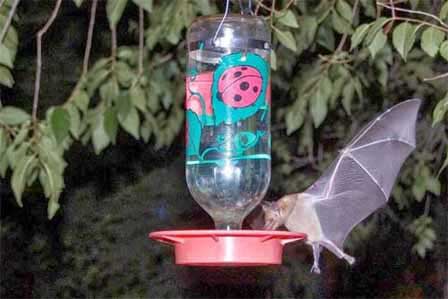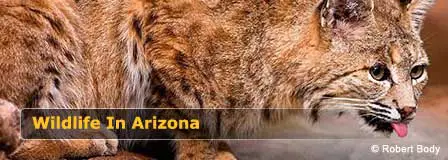Species of Bats in Arizona
 © Ken Bosma
© Ken BosmaIt's really no surprise that when temperatures reach triple digits, nearly every outdoor activity takes place after the sun has made her exit in an exquisite swirl of crimson and amethyst clouds. Hot summer nights in the southwest always remind me of backyard barbeques, pool parties and live concerts under starry skies. But there is one overlooked and decidedly unusual evening activity to consider. Bat-watching! Yes, it's during these most enjoyable hours, when we bathe in the sweet escape of darkness that the only mammals in the world who fly are also out on the town.
Those uneducated on the virtues of bats often think them egregious, their minds filling with thoughts of Halloween and Dracula at the mere mention of them. Of course the ballyhoo of scariness surrounding bats is all a ruse, brought on by too many campfire stories and Hollywood movies. Bats are not rodents, they're not blind and they don't get tangled in people's hair. Truth be told, these interesting, mysterious creatures of the night play an extremely important and necessary role in our state's ecology.
In Arizona, we are privileged to share our environment with a variety of bats. To be precise, we host the second greatest number of bat species in the United States, just behind Texas. They flutter in deep evening skies as little brown wonders, pollinating native flora and keeping the insect populations in check.
There are 986 species of bats in the world, twenty-eight of those reside in our state. Only two are nectar/pollen eaters, essential to the pollination of Saguaro cactus and many types of agaves. They zip from bloom to bloom like oversized bees working the graveyard shift, poking their heads into flowers and transporting tiny vital spores on their fur. These bats also ingest seeds which are later disseminated in their droppings.
The other twenty-six species dine exclusively on bugs, with colonies consuming thousands of insects per night. Small brown bats are the most common group found in Arizona and play a major role in managing insect populations. These insectivores have well-developed ears and tiny eyes. They can see, but mainly rely on their ability to echolocate; using reverberating sound waves to get a 3-D sense of their environment (similar to the process used by dolphins).
Bats utilize a variety of techniques to catch prey. Our smallest bat - the Western pipistrelle - is an aerial-eater, seizing flying insects on the wing. The California leaf-nosed bat can actually hover in flight, gleaning insects and larva from vegetation. And some bats prefer ground crawlers, like the unique Pallid bat who is notorious for munching scorpions, unharmed.
As word spreads about the pest control benefits of these gentle helpful neighbors, so does their popularity, and in recent years, nature enthusiasts of all ages have been converging on local shops seeking bat houses to install at their homes. The growing fondness for this once-forsaken creature warms my heart, but it is important that people are also careful.
Even though a very small number of animals carry the disease, bats are still the number one reservoir for rabies virus in our state . Of course I am the first person to encourage people to step up to the plate and take action to help a critter in need. However, picking up a sick or injured bat found on the ground is tricky business indeed. An uneducated move can potentially expose someone to a dangerous disease. Remember, bats simply don't end up on the ground unless they are extremely sick, so here's the scoop: If a bat is found unable to fly, it is important to remove pets and children from the area, since they can be curious enough to carelessly touch it. Safely contain the bat by putting a bucket or box over it and get assistance with the situation right away. If there has been physical human contact, notify Animal Control immediately, but if the animal has been untouched, a wildlife rehabilitation organization like Liberty Wildlife (480-998-5550) or Southwest Wildlife (480-471-9109) can be called for advice.
With wisdom and curiosity on your side, bats can prove to be an especially interesting subject - worth exploring. So, if you're tired of your summer routine and watching TV is making you go batty, take your family, favorite bat book and some popcorn, go out under the night sky and look up. Perhaps you'll catch a glimpse of these nocturnal critters and discover the fascinating and wonderful world of bats.
Arizona Bat Species
Ghost-faced bat Mormoops meglophylla
California leaf-nosed bat Macrotus californicus
Mexican long-tongued bat Choeronycteris mexicana
Lesser long-nosed bat Leptonycteris curasoae
Yuma myotis Myotis yumanensis
Cave myotis Myotis velifer brevis
Occult little brown bat Myotis lucifugus occultus
Long-eared myotis Myotis evotis
Southwestern myotis Myotis auriculus
Fringed myotis Myotis thysanodes
Long-legged myotis Myotis volans
California myotis Myotis californicus
Western small-footed myotis Myotis ciliolabrum
Silver-haired bat Lasionycteris noctivagans
Western pipistrelle Pipistrellus hasperus
Big brown bat Eptesicus fuscus
Western red bat Lasiurus blossevillii
Southern yellow bat Lasiurus ega
Hoary bat Lasiurus cinereus
Spotted bat Euderma maculatum
Allen's lappet-browed bat Idionycteris phyllotis
Townsend's big-eared bat Corynorhinus townsendii
Pallid bat Antrozous pallidus
Mexican free-tailed bat Tadarida brasiliensis mexicana
Pocketed free-tailed bat Nyctinomops femorosaccus
Big free-tailed bat Nyctinomops macrotis
Greater western mastiff bat Eumops perotis californicus
Underwood's mastiff bat Eumops underwoodi
Arizona Animals















